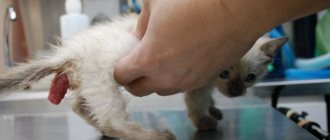Although man considers himself the crown of nature, we and our smaller brothers are similar in many ways. For example, we are often affected by the same ailments - gastritis, cystitis, stomatitis, tuberculosis, cancer. Yes, yes, oncology also occurs in animals, and quite often.
Which animals are most likely to get cancer?
According to our expert, oncology is not a leader, but is among the TOP 10 animal diseases, accounting for approximately 20% of the total number of tailed patients.
Rodents most often suffer from cancer. When kept at home, when there is no need to take care of housing, food and protection from competitive individuals, their immunity is not able to fight malignant cells at full strength. In addition, rodents in general do not live long: the average white mouse is already a decrepit wreck at three years old. This is why these animals rarely die of old age. Usually, at the end of the day, they literally become overgrown with tumors and burn out in a matter of weeks.
In second place in the ranking of cancerous animals are cats, and dogs close the top three.
— In general, the picture of morbidity can be greatly distorted by the fashion for animals. For example, several years ago fighting dog breeds were popular, but now miniature decorative dogs are preferred. At the same time, cats in general are adopted more often than other pets, which means that they will be treated objectively more often for oncology, explains Natalya Mezentseva.
How does animal cancer differ from human cancer?
Hormone-dependent cancer is very rare in animals. This means that when performing, for example, an operation to remove a mammary gland tumor in a cat, there is no point in prophylactically cutting out the animal’s ovaries - in terms of oncology, these organs of the reproductive system do not have a hormonal connection. Dogs do have hormone-dependent mammary tissue, but hormone-dependent cancer is also very rare.
Cancer tumors also differ at the cellular level - it is not for nothing that medical and veterinary histologists often interpret the same cellular material in different ways.
But where animal and human cancer are uniquely similar is that the disease has clearly become younger in recent years. Both people and animals began to get sick more often during active reproductive age. Why - scientists have not yet found an answer to this question.
What types of cancer are animals susceptible to?
In first place is breast cancer. Next come virus-related lymphomas and malignant tumors of the musculoskeletal system - various sarcomas.
How and why animals get cancer Photo: Yulia SOLNTSEVA
Why do animals get cancer?
There are three main causes of cancer in animals. Injuries and bruises cause osteosarcomas. Diseases such as immunodeficiency and viral leukemia often lead to lymphomas of the internal organs. Genetic mutations cause tumors such as thymomas, skin mastocytomas, osteochondral osteochondromas, tumors of nerve tissue and membranes.
Can stress cause cancer in animals?
How could it? This is especially true for cats.
— A cat, in principle, is a creature of a very subtle mental organization, like a crystal vase in the animal world. When she experiences extreme stress, you may not even suspect what is happening to her - outwardly, as a rule, she will be Olympian calm and unperturbed,” Natalya Mezentseva shares her observations.
As a reaction to severe stress, cats often (in 60% of cases) develop idiopathic cystitis - inflammation of the bladder wall, accompanied by bleeding. Against the background of stress, under the influence of cortisol and adrenaline, the permeability of the bladder lining changes, and it begins to bleed.
How to tell if an animal has cancer
— Animals are very patient by nature. For this reason, symptoms are often missed by owners, and specialists are contacted only when the disease has reached the metastatic stage and the tumor is easily palpable with hands, says the expert.
Veterinarians strongly recommend not to ignore symptoms such as prolonged refusal to eat, exhaustion that does not go away within several days, coughing and wheezing, decreased aesthetic parameters of the coat (dullness, bald spots or tangles), and physical activity.
— If your pet doesn’t come out to meet you, doesn’t play, or hides in dark places, this is a serious cause for concern! - says the expert
How do experts diagnose cancer in animals?
A simple consultation with a veterinarian is enough to get started. Skin mastocytomas, venereal sarcomas, and squamous cell carcinoma of the oral mucosa can be felt by a specialist with their hands or seen with their eyes. By the way, for this reason, cancer is more often detected in the early stages in short-haired and hairless animals than in their shaggy counterparts.
An ultrasound of internal organs, CT (computed tomography), MRI (magnetic resonance imaging) is also performed on animals - if the necessary equipment is available in the clinic. Laboratory diagnostic methods include cytology and histology of cellular material - large veterinary centers have all the necessary equipment for this, and veterinarians are trained in the rules for collecting biomaterial using the fine-needle biopsy method.
How is cancer treated in animals?
Just like with people. Surgical treatment is performed under general anesthesia (intravenous, gas and epidural anesthesia). If a veterinary clinic offers to quickly perform an operation on your pet under local anesthesia, then you should seriously think about the quality of the services provided here, experts warn.
On average, operations last from 40 minutes to one and a half hours. The animal recovers after surgery in 1-2 weeks.
How and why animals get cancer Photo: Yulia SOLNTSEVA
Radiation treatment for animals is also carried out, although it is extremely rare - in Russia there are only 2-3 centers providing such services. For radiotherapy, conventional radiation equipment is used - there are no special devices for animals. The four-legged patient is given hypnotics, which do not put him into deep anesthesia, but only briefly turn off consciousness, and he lies motionless throughout the entire procedure.
“By the way, getting a needle into the veins and threads of animals is a real art; their threads are much thinner even than those of children,” explained Natalya Mezentseva.
And one more thing: surprisingly, animal hair does not fall out after chemicals, unlike human hair, when this happens in almost 99% of cases!
How much does treatment cost?
Veterinary medicine is not included in the area of compulsory health insurance; all services there are paid. For example, a course of surgical treatment of cancer in animals in Barnaul can cost from 1,500 to 15,000 rubles. The course of chemotherapy is calculated without taking into account antitumor drugs (the owners buy them themselves); the cost, as a rule, includes drugs for palliative care - electrolytes, antiemetics, metabolic drugs.
The price range depends on the volume of work, the quality of consumables, the composition of the assistant team, and the availability of a temporary hospital. However, experts advise that when choosing a veterinarian for your patient, you should focus primarily on the professional reputation of the specialist and customer reviews.
“Price should not be the main selection criterion, because expensive, as well as cheap, can end up being equally bad,” says Natalya Mezentseva.
How often do animals die from cancer?
Is there palliative care for four-legged animals?
The work of any Aibolit, as well as human doctors, is based on the principle of humanity.
“We prescribe painkillers or medications that reduce stress to seriously ill animals, and we optimize their diet in order to somehow improve their quality of life,” says Natalya Mezentseva.
What examinations should your pet undergo?
This depends on the life expectancy of the animal, because cancer often develops in old age. For large dogs, 9 years is often the age limit, but small dogs can live up to 20 years. The average lifespan of cats is 15 years.
The list of examinations includes a visual examination, during which the doctor can identify, among other things, the prerequisites for the development of oncological pathologies. Instrumental studies include ultrasound of internal organs and chest X-ray.
By the way
Is it possible to get cancer from meat breeds of animals that suffer from cancer - poultry, pork, beef?
Dying cat and causes of death
Domestic cats with good care live on average 14-15 years, some live to a very old age - 19-25. Animals die of old age or disease.
Among the critical pathologies leading to death are:
- renal failure is diagnosed in 70% of cases and is most often associated with advanced urolithiasis, when treatment is not carried out in a timely manner and the animal enters the clinic with critical kidney damage. In other cases, poor kidney function is associated with acute internal processes in the body, including poisoning;
- oncology. Malignant neoplasms are fatal in 95% of cases, and this is explained by an asymptomatic course at first and large-scale lesions at stages 3-4 (metastases), when obvious symptoms appear and the breeder decides to show the cat to a doctor. Medicines and surgeries only slightly prolong a pet's life;
- infectious diseases (especially FIV, infectious peritonitis, viral leukemia). Some of them have no cure and are almost always fatal.
Cats live less than people. You need to be prepared for this, and in any case, the breeder will one day be faced with a choice: urgently treat the animal or accept it, realizing that the cat is dying.
Lymphoma treatment
The main direction in the treatment of lymphosarcoma is chemotherapy, which involves the administration of cytotoxic drugs to destroy tumors. These drugs have a destructive effect not only on tumor cells, but also on healthy cells of internal organs and body systems, therefore chemotherapy regimens and doses are selected exclusively by a veterinarian. Among the most commonly used drugs:
- Doxorubicin;
- Chlorambucil;
- Cyclophosphamide;
- Vincristine;
- L-asparaginase (in case of leukemia);
- Prednisolone/prednisone (to relieve inflammation and suppress tumor development).
Medicines are given to the animal once a week, and the course lasts 4-6 months. If, at the end of the first course, it is possible to achieve remission, at the veterinarian’s discretion, chemotherapy is stopped or the interval between drug administrations is increased to 2 weeks.
Radiation therapy is not used for lymphoma. If the tumor interferes with the normal functioning of the animal, it is surgically removed, after which chemotherapy and restorative drugs are also prescribed.
Why are they leaving?
Cats that are free to go outside almost always disappear when death approaches. In packs of stray animals, also, sensing the approach of death, dying cats hide. Why this happens is not known for certain, but there are several versions:
- a feeling of weakness, the inability to resist an attack, pain - like danger, all this forces the cat to flee;
- solitude for the purpose of healing, coming to your senses;
- the reluctance to upset the owners is a pure theory, an assumption based on the impressionability inherent in a person.
In any case, based on many years of observations, veterinarians can say that a cat's behavior changes before death. And this is very noticeable to the owner, even if he did not have a close relationship with the pet.
Treatment
Attention!
Lymphoma is a disease that cannot be completely cured.
The life expectancy of an animal depends on the timely diagnosis, the type of lymphoma, its stage and the condition of the animal.
Therapeutic measures are aimed at increasing the cat’s life expectancy and improving its quality.
Chemotherapy is widely used for treatment. The dosage of drugs is prescribed in each case individually and depends on the weight of the animal, its age and condition.
Monochemotherapy
This type of therapy means treatment with one drug, is ineffective and is practically not used. Most often, with monochemotherapy, Doxorubicin or Cyclophosphamide is used.
Reference!
The method is used only in cases of severe intoxication of the animal’s body or when there is a danger of developing side effects when using combined treatment.
Combined
Combined chemotherapy includes several treatment regimens:
- SOR: “Prednisolone” + “Cyclophosphamide” + “Vincristine” (low degree of side effects, lower cost).
- ASOR: Prednisolone + Vincristine + Doxorubicin + Cyclophosphamide (used in more severe cases).
Operationally
Surgery is used only when the condition interferes with the normal functioning of the body. For example, with intestinal obstruction, severe blood loss, and a large accumulation of tumors. The operation, in this case, provides only symptomatic assistance.
What should a breeder do?
A breeder can make the transition to another world easier if:
- equips a bed in a warm place;
- Place a tray and food nearby so that the cat can reach them;
- will provide peace and quiet;
- As prescribed by the doctor, she will administer painkillers if the pet is suffering from pain.
A veterinarian, having examined the animal and determined that the pet is dying from an incurable disease or is in great pain, will offer the breeder euthanasia. In this case, the procedure is humane, as it makes the cat easier to care for and relieves it from suffering. The owner must make a decision, but always remember that what should come first is not his feelings and bitterness from the loss of his pet, but ensuring peace for the dying cat, relieving it of pain and suffering.
What do cat owners need to know about neoplasms and cancer?
A tumor (neoplasia, neoplasm) is an uncontrolled abnormal growth of cells and tissues in the body, which can be malignant or benign. Benign tumors grow more slowly and do not metastasize. Malignant neoplasms are more aggressive, they grow quickly and invade healthy tissue and spread throughout the body (metastasize). Malignant neoplasms are called cancer.
Tumors are quite common in cats, and as the animal ages, the risk of developing a tumor increases. More than half of deaths in domestic cats after 10 years of age are due to cancer.
In order not to miss the onset of the pathological process, it is important to regularly show your cat to your veterinarian. If oncology is suspected, a thorough examination of the animal is necessary, which includes examination, radiography (X-ray), blood tests (biochemical and general clinical), ultrasound, biopsy of the tumor, as well as a biopsy of the regional lymph node in order to determine the extent of the lesion.
Unfortunately, it is almost impossible to predict the occurrence of cancer. Therefore, only timely medical examination of the cat will help to identify the disease as early as possible and take all measures for effective treatment, which can be surgical or conservative.
What tumors are most common in cats?
Skin cancer is less common in cats than in dogs, but is predominantly malignant. Watch for the appearance of tumors and pigment spots on the animal’s skin.
Feline mammary tumors (FMTs) account for approximately 85% of all tumors found in cats. These are usually malignant tumors. Neutering your cat before one year of age will significantly reduce the risk of AMF. Examine the breast area periodically.
Tumors in the oral and nasal cavities can also be cancerous. These are indicated by bleeding, bad breath, difficulty breathing or swallowing.
Lymphoma is a common form of neoplasia in cats. It is characterized by enlargement of one or more lymph nodes.
Bone tumors are clearly visible in cats, but are quite rare.
Each type of neoplasia requires an individual approach. The method of treatment depends on the type of tumor and the general condition of the animal. This may be chemotherapy, radiation, cryosurgery, immunotherapy or surgery. Only a veterinary oncologist will select the best treatment option. Some types of neoplasia (benign) are treatable.
Even if your cat has cancer, you can reduce the spread of malignant cells and prolong your pet's comfortable life (depending on the type of tumor and the extent of the damage). But if the cancer has metastasized and the animal’s condition is very serious, doctors, with the consent of the owner, resort to euthanasia (humane euthanasia).
10 signs that may indicate cancer: - abnormal swelling, lumps that continue to grow (tissue growths) - ulcers that do not heal - weight loss - loss of appetite and thirst - bleeding from any organ - difficulty in natural processes (swallowing, breathing , defecation, etc.) - unpleasant fetid odor - decreased activity, apathy, weakness - subcutaneous neoplasms, including in the mammary glands - formations in the ears.
Health to you and your animals!
Cited 4 times Liked by: 3 users
All malignant tumors are called cancer, and they received this name because of their irregular shape with ragged edges, reminiscent of tentacles. Cancerous tumors do not have clear boundaries and are accompanied by severe gnawing pain. Intestinal cancer (lymphoma) is rarely diagnosed in cats, but this type of tumor metastasizes widely and causes intestinal blockage.
The danger of intestinal cancer in cats, as in other animals, is that the stage of its development when the tumor can be completely removed is usually asymptomatic. But in any case, the earlier the disease is detected, the more favorable the treatment prognosis, so it is very important to consult a veterinarian at the first signs.
He will order a thorough examination, including a biochemical blood test to assess electrolyte balance and determine the amount of protein in the serum, a biopsy followed by cytology to determine the type of tumor, and x-rays to determine its size and location.
Etiology of the disease
The risk of developing oncological pathologies of the gastrointestinal tract increases when feeding cats fatty, fried, and salty foods. Some breeds are more prone to cancer, such as Siamese cats, and older animals are more likely to get the disease. Viral infections increase the chance of developing a tumor, but they are rare. Risk factors include harmful substances in the atmosphere, carcinogens, and excessive exposure to sunlight. The etiology of diseases such as a stomach tumor in a cat and other malignant tumors has not been fully identified.
Symptoms of intestinal cancer in a cat
Among the specific symptoms of developing intestinal cancer in a cat are the following:
- intestinal dysfunction - diarrhea alternates with constipation, blood and mucus are noticeable in the stool, if the tumor is located in the small intestine, the stool may turn black. If a cat has colon cancer, bloody, foul-smelling discharge or bleeding from the anus is likely;
- detection of lumps that can be felt through the abdominal wall may indicate the presence of a neoplasm in the intestine; dense lumps in the groin may be enlarged lymph nodes; an urgent consultation with a doctor at a veterinary clinic is necessary.
Diagnosis of intestinal cancer is quite difficult due to the fact that it also has nonspecific symptoms that are common to other diseases. Among them:
- frequent vomiting with blood, bile, mucus;
- foul odor from the mouth;
- weight loss, poor appetite, lethargy caused by internal bleeding;
- the cat periodically screams, then sits with its mouth open and breathes heavily, rapid heartbeat (tachycardia), absent-minded gaze;
- exhaustion (cachexia) and complete lack of appetite accompany cancer in the last stage.
Any of the symptoms of intestinal cancer in cats should not be discussed on an animal lovers forum, but only with a veterinary oncologist. Next, we will tell you what to do if your cat is confirmed to have intestinal cancer. There is no need to panic, you need to pull yourself together and unite in the fight to prolong the life of your pet.
Types of Cancers
Lymphomas, adenocarcinomas, mastocytomas, polyps and neoplasia are often found in cats. More details about each:
- Alimentary lymphoma is a tumor formed from lymph. Metastases quickly spread to neighboring tissues and organs. The animal loses its appetite, the stomach increases in volume, diarrhea alternates with constipation.
- Intestinal adenocarcinoma. Develops from the epithelium. The prognosis depends on how quickly the owner contacted the veterinarian. It progresses quickly and metastasizes to other organs. The first symptoms: constipation and intestinal obstruction.
- Mastocytoma. Comes from cells that secrete heparin, histamine and hormones. A sign of pathology is intestinal inflammation and diarrhea. Metastasizes to lymph nodes.
- Polyps. Most often occur in the large intestine. They are often benign, but they tend to degenerate into adenocarcinoma.
- Neoplasia. There are benign and malignant. It is aggressive, develops quickly, grows into neighboring tissues and metastasizes.
What to do if your cat has intestinal cancer?
Cancer is a very complex disease, and only a highly qualified specialist can help you. The main methods are surgery to remove the tumor and chemotherapy. Radiation therapy is not used often because it is difficult to precisely target the affected area, but it is used to treat tumors in the anal area.
Chemotherapy is the use of chemicals to destroy tumor cells, which is carried out before and after surgery and quite effectively prevents the formation of metastases, that is, the spread of the tumor to other organs and tissues. Chemotherapy is tolerated fairly well by most cats, although it may be accompanied by whisker loss.
Features of treatment
The mainstay of treatment for lymphoma is chemotherapy. In 60% of cases, a positive reaction of the cat’s body to this method of combating the disease is achieved. If the disease is advanced, improvement is observed in only 5% of animals. The course of chemotherapy lasts 4–6 months, during which the pet is given the necessary medicine once a week. To monitor the effectiveness of the course, laboratory tests are periodically carried out.
Monochemotherapy involves the use of one type of drug. Typically, cyclophosphamide or doxorubicin are used. However, this type of therapy is ineffective, so most often the animal is prescribed a combination treatment of several drugs.
Two schemes for receiving funds have been developed:
- SOP, which includes Cyclophosphamide, Prednisolone and Vincristine. The treatment takes place without severe side effects and is inexpensive.
- ASOR with simultaneous use of Cyclophosphamide, Vincristine, Prednisolone, Doxorubicin. The regimen is indicated for the treatment of severe stages of the disease.
If the lymphoma reaches a large size and threatens the life of the quadruple patient, surgical removal of the tumor is performed. After the operation, the animal is prescribed a mandatory course of chemotherapy. When stable remission is achieved, the condition improves significantly, but this does not mean that the patient becomes healthy. Your pet should be seen by a veterinarian every 3 months.
How to make life easier for a cat with intestinal cancer
Despite the high effectiveness of chemotherapy for intestinal cancer in cats, the animal’s condition does not improve immediately, and therefore additional drugs are used to make life easier for your cat if he has intestinal cancer.
Owners often worry whether it is safe to give hormones to their animals. For example, dexamethasone is actively discussed on forums - for intestinal cancer in a cat, this medicine (a synthetic analogue of the adrenal hormone) slows down and sometimes completely stops the growth of malignant cells, relieves inflammation, and improves the psycho-emotional background of the animal.
In combination with cerucal or serenium, dexamethasone enhances the effect of painkillers, helps to cope with vomiting, which often accompanies chemotherapy, and also increases the level of leukocytes and helps prevent complications after chemotherapy. Dexamethasone is often prescribed for lifelong use. Also, to make the life of a cat with intestinal cancer easier, painkillers, antispasmodics, laxatives, adsorbents, and antacids are prescribed.
So, intestinal cancer in cats is not a death sentence; there are statistics that more than 40% of animals survive after treatment and, although we cannot talk about complete recovery, the period of remission can last up to 5 years, and these are happy years spent next to your pet!
Life forecast
The use of modern drugs with reduced toxic effects on the body and the high sensitivity of different types of lymphomas to chemotherapy make it possible to achieve long-term, stable remission during this cancer. The prognosis for the life expectancy of a cat with lymphoma depends largely on the location of the tumor and the timeliness of therapy.
Important! In the absence of treatment or the use of only prednisolone, the life expectancy of an animal after diagnosis of lymphosarcoma is 1-2 months. In addition, the presence of leukemia virus and immunodeficiency virus should be taken into account
The average life expectancy statistics with lymphoma after completing a course of chemotherapy and subject to timely detection are as follows:
In addition, the presence of leukemia virus and immunodeficiency should be taken into account. The average life expectancy statistics with lymphoma after completing a course of chemotherapy and subject to timely detection are as follows:
- 65% – 12 months;
- 30% – 24 months;
- 15% - from 36 months or more.
Even achieving stable remission does not mean complete recovery of the pet. He will need regular observation by a veterinarian, at least once every 3 months, and adherence to the prescribed diet.











